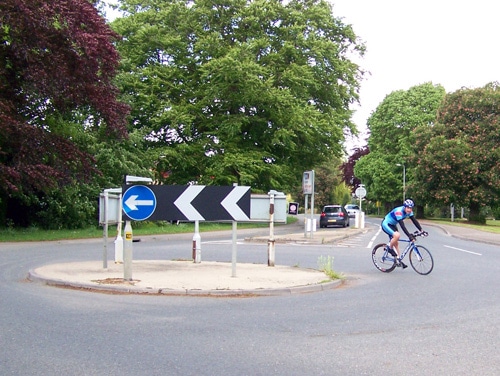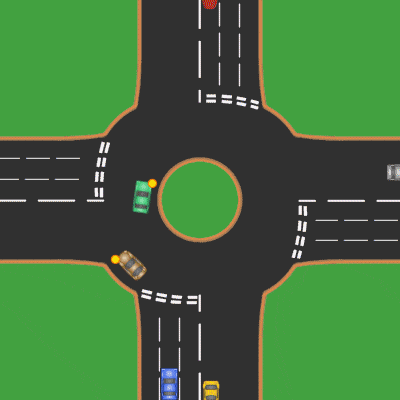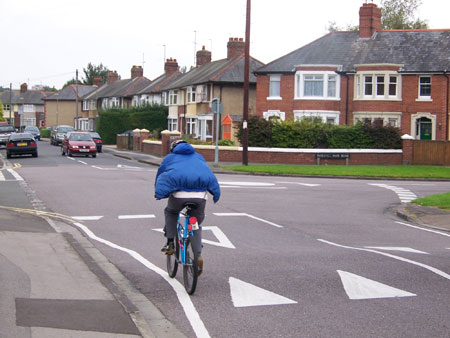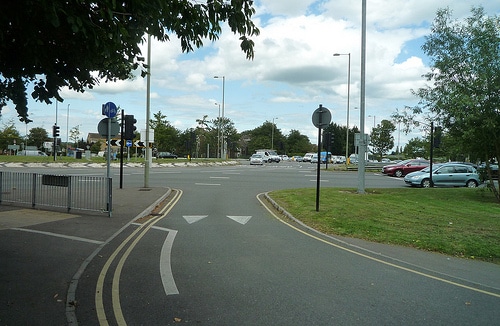When in Dublin, I was surprised a friend had no idea about the basic rule of roundabouts. He cycles into town everyday, but didn’t know at roundabouts you are supposed to give way to traffic coming from your right.
I only noticed because at one roundabout. I waited, and he just cycled on into the path of a car causing it to slow down. He was actually surprised to learn you were supposed to give way. Maybe he spent too long in Paris, where it really is ‘first come, first served’

The Basic Practical Rules of Roundabouts

Roundabouts in theory
- Give way to traffic on the roundabout. Only join, when it is safe.
- If you are taking last exit or effectively turning right, you should signal right and ideally be in the right hand lane.
- The highway code states that cyclists can stay in the left hand lane, even if taking last exit. If you do stay in the left hand lane it is important to signal right, until before the last exit where you signal left to turn off the roundabout.
- However, I like to look over my shoulder, and if reasonably safe I will signal right and move into right hand lane. I think this is better than staying in left hand lane. True, the highway code says cyclists can stay in left hand lane, but, in practical terms many motorists may not know (or expect) that.

Rules When on Roundabouts
- When on a roundabout, you should in theory have right of way over cars joining. However, you can’t take it for granted people will always follow the rules, especially at mini roundabouts. When I’m on a roundabout, I try to eyeball any driver joining because some may join anyway.
- Signal left when you come off, and make sure a car isn’t overtaking on the inside.
If you feel unsafe at very large roundabouts, you can always dismount and go across each intersection.
Mini Roundabouts

Mini roundabouts are becoming increasingly common. But, by experience suggests people become even more insecure about who has right of way – or people forget.
If the cyclist was turning right, a majority of motorists do not give way, but keep going straight across the roundabout. If you are not aware that most cars will keep going, an accident is quite likely. For some reason, motorists / road users don’t see the give way markings on the road or don’t really see it as a roundabout.
This is on my commute home. It is very rare a car, will stop to allow you to go round the mini roundabout and come off. If you want to avoid an accident, the onus seems to be on the cyclist to give way to the motorist driving straight on. I’ve learnt from experience, never expect the car to give way.
Also, with mini-roundabouts. If you are turning right, it helps to signal turning right. Rather than for a big roundabout, where you would signal left to come off the roundabout.
Really big roundabouts that deter cyclists

Some roundabouts are just too big, busy for cyclists to feel safe. This can be a major deterrent for cyclists making a journey to work.

This is Headington roundabout in East Oxford. There is actually an underpass under the roundabout. It is not ideal, because signs tell you to dismount, it takes ages to walk. But, it’s worth taking the safer underground route.

The Highway code on Roundabouts
160. On approaching a roundabout take notice and act on all the information available to you, including traffic signs, traffic lights and lane markings which direct you into the correct lane. You should
• use Mirrors – Signal – Manoeuvre at all stages
• decide as early as possible which exit you need to take
• give an appropriate signal (see Rule 162). Time your signals so as not to confuse other road users
• get into the correct lane
• adjust your speed and position to fit in with traffic conditions
• be aware of the speed and position of all the traffic around you.
161. When reaching the roundabout you should
• give priority to traffic approaching from your right, unless directed otherwise by signs, road markings or traffic lights
• check whether road markings allow you to enter the roundabout without giving way. If so, proceed, but still look to the right before joining
• watch out for vehicles already on the roundabout; be aware they may not be signalling correctly or at all
• look forward before moving off to make sure traffic in front has moved off.
162. Signals and position, unless signs or markings indicate otherwise.
When taking the first exit
• signal left and approach in the left-hand lane
• keep to the left on the roundabout and continue signalling left to leave.
When taking any intermediate exit
• select the appropriate lane on approach to and on the roundabout, signalling as necessary
• stay in this lane until you need to alter course to exit the roundabout
• signal left after you have passed the exit before the one you want.
When taking the last exit or going full circle
• signal right and approach in the right-hand lane
• keep to the right on the roundabout until you need to change lanes to exit the roundabout
• signal left after you have passed the exit before the one you want.
When there are more than three lanes at the entrance to a roundabout, use the most appropriate lane on approach and through it
163. In all cases watch out for and give plenty of room to
• pedestrians who may be crossing the approach and exit roads
• traffic crossing in front of you on the roundabout, especially vehicles intending to leave by the next exit
• traffic which may be straddling lanes or positioned incorrectly
• motorcyclists
• cyclists and horse riders who may stay in the left-hand lane and signal right if they intend to continue round the roundabout
• long vehicles (including those towing trailers) which might have to take a different course approaching or on the roundabout because of their length. Watch out for their signals.
164. Mini-roundabouts Approach these in the same way as normal roundabouts. All vehicles MUST pass round the central markings except large vehicles which are physically incapable of doing so. Remember, there is less space to manoeuvre and less time to signal. Beware of vehicles making U-turns.
Related

You’re only supposed to use the left lane on a roundabout as a cyclist. Following from THC:
77. You may feel safer walking your cycle round on the pavement or verge. If you decide to
ride round keeping to the left-hand lane you should
be aware that drivers may not easily see you
take extra care when cycling across exits. You may need to signal right to show
you are not leaving the roundabout
watch out for vehicles crossing your path to leave or join the roundabout.
However people often get confused because of the wording of this rule:
Rule 187
In all cases watch out for and give plenty of room to
pedestrians who may be crossing the approach and exit roads
traffic crossing in front of you on the roundabout, especially vehicles intending to leave by the next exit
traffic which may be straddling lanes or positioned incorrectly
motorcyclists
cyclists and horse riders who may stay in the left-hand lane and signal right if they intend to continue round the roundabout. Allow them to do so
long vehicles (including those towing trailers). These might have to take a different course or straddle lanes either approaching or on the roundabout because of their length. Watch out for their signals.
When it says “may stay in the left-hand lane and signal right if they intend to continue round” it means as opposed to leaving at that exit – it doesn’t mean unless they choose to ride in the right hand lane. The first part is much clearer, that we are to keep to the left hand lane if we decide to ride around rather than dismounting.
Lilly,
In my opinion Rule 77 provides additional guidance for cyclists who decide to stay in the left hand lane despite the fact they are turning right (something other road users are not supposed to do – rule186). If it was intended to restrict cyclists to the left hand lane it should be an explicit instruction
ie “Cyclists must remain in the left hand lane when negotiating a roundabout”.
On many roundabouts, particularly those with small gaps between exits, or where most of the traffic is going straight on, turning right by cycling around the outside of the roundabout is just plain dangerous. There is one on my daily commute where I reckon sticking to the left hand lane would give me a 50-50 chance of an accident each time I used it.
Rule 77 does not say you can keep to the left lane, it says you should keep to the left lane (and that you may wish dismount and walk across if you feel it would be safer). The same the rest of the code says that drivers should give plenty of room to cyclists, should take extra care around cyclists, should give way to traffic on the right at roundabouts etc.
So are you saying that car drivers don’t need to give us enough room, dont need to take extra care around us since the code says should and not must?
There is a reason cyclists are supposed to stay to the left lane (although note it is the left lane – so nothing to stop you riding in the middle of the lane which takes you away from the edge). That is because the risk of accident is higher when changing lanes and its very rarely just a bump for us.
Section 76 states… Follow the rules for cars, which provides an exception for cyclists to stay in the left hand lane if they choose to. S 77 deals with cyclists who choose to stay in left hand lane, which is an exception. Safer imo to follow procedure for cars as 1. Cars turning left may not know you are carrying on. 2. Cars joining roundabout may not know you are going straight on. Thanks for helpful advice and links to relevant sections.